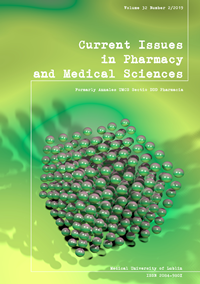Effect of addition of recast materials on characteristics of Ni-Cr-Mo alloys
DOI:
https://doi.org/10.2478/cipms-2019-0014Słowa kluczowe:
nickel alloys, metal-ceramic bonding, three-point bond test, recastingAbstrakt
The purpose of this study was to assess the effect on selected mechanical properties, of adding recast materials to the NiCrMo alloy of newly produced castings.Three groups of dental alloy NiCrMo (trade named Remanium CS+) were prepared by mixing 50% new alloy to alloy remnants from previous castings. The specimens in the first casting group used 100% new alloy and served as control (C1). The second group consisted of equal amounts of new alloy and alloy remnants cast only once (C2). The third group contained 50% of new alloy and alloy cast twice (C3). Microstructural analysis was performed and the chemical composition, hardness and the metal-ceramic bond strength were assessed. In addition, EDS analysis (mapping) was undertaken. Hardness and bond strength results were also statistically analysed.In spite of the fact that recasting brought about small changes in hardness and chemical composition (C, Cr and Mo), these effects were found to not affect their functional properties in the oral cavity. Still, significant differences between new alloy and the recasted groups (p < 0.05) were demonstrated in the course of statistical analysis of Vickers hardness test (for α = 0.05). All analysed research groups have a similar average adhesion at 48.51÷49.24 MPa (p > 0.05).The recasting procedure described in the paper can be done safely in dentistry. If previously casted material is used, it should be mixed with new material. The use of the material prepared in this way can lower the costs of NiCrMo castings.
Bibliografia
1. Leinfelder KF. An evaluation of casting alloys used for restorative procedures. J Am Dent Assoc. 1997:37-45.
2. Wylie ChM, Shelton RM, Fleming GJP, Davenport AJ. Corrosion of nickel-based dental casting alloys. Dent Mater. 2007:714-23.
3. Yilmaz H, Dinçer C. Comparison of the bond compatibility of titanium and an NiCr alloy to dental porcelain. J Dent. 1999:215-22.
4. Palaskar J, Nadgir DV, Shah I. Effect of Recasting of Nickel: Chromium Alloy on its Castability. J Indian Prosthodont Soc. 2010:160-4.
5. Walczak M, Beer K, Surowska B, Borowicz J. The issue of using remelted CoCrMo alloys in dental prosthetics. Arch Civ Mech Eng. 2012:171-7.
6. Walczak M. Influence of the selected technological processes on durability of metal-ceramic systems used in dental prosthetics. Lublin: Published by Lublin University of Technology; 2014:120-2.
7. Walczak M, Pieniak D, Niewczas AM. Effect of recasting on the useful properties CoCrMoW alloy. Eksploatacja i Niezawodnosc – Maintenance and Reliability. 2014: 330-6.
8. Reisbick MH, Brantley WA. Mechanical property and micro-structural variations for recast low-gold alloy. Int J Prosthodont. 1995:346-50.
9. Bauer J, Cella S, Pinto MM, Costa JF, Reis A, Loguercio AD. The use of recycled metal in dentistry: Evaluation of mechanical properties of titanium waste recasting. Resour Conserv Recy. 2010:1312-26.
10. Peraire M, Martinez-Gomis J, Anglada JM, Bizar J, Salsench J, Gil FJ. Effects of Recasting on the Chemical Composition, Microstructure, Microhardness, and Ion Release of 3 Dental Casting Alloys and Titanium. Int J Prosthodont. 2007:286-8.
11. Al-Ali AA. Evaluation of Macrohardness of Recasted Cobalt–Chromium Alloy. Al-Rafidain Dent J. 2007:111-7.
12. Ozyegin LS, Tuncer R, Avci E. Hardness, Behavior and Metal Surface Evaluation of Recasting Non-Precious Dental Alloys. Key Eng Mater. 2007:1425-8.
13. Horasawa N, Marek M. The effect of recasting on corrosion of a silver-palladium alloy. Dent Mater. 2004:352-7.
14. Al-Hiyasat AS, Darmani H. The effects of recasting on the cytotoxicity of base metal alloys. J Prosthet Dent. 2005:158-63.
15. Yavuz T, Acar A, Akman S, Ozturk AN. Effect of Surface Treatment on Elemental Composition of Recast NiCr Alloy. Mater Sci Appl. 2012:163-7.
16. Ucar Y, Aksahin Z, Kurtoglu C. Metal ceramic bond after multiple casting of base metal alloy. J Prosthet Dent. 2009:165-71.
17. ISO 9693:2002, Metal-ceramic dental restorative systems. Geneva: International Organisation for Standardization; 2002.
18. Bauer JRO, Loguercio AD, Reis A, Filho LER. Microhardness of Ni-Cr alloys under different casting conditions. Braz Oral Res. 2006;20:40-6.
19. Anusavice KJ. Phillips’ Science of Dental Materials. 10th ed. Philadelphia: WB Saunders Company; 1996:457-63.
20. Presswood RG. Multiple recast of a nickel-chromium-beryllium alloy. J Prosthet Dent. 1983:198-9.
21. Palaskar J, Nadgir DV, Shah I. Effect of recasting of Nickel-Chromium alloy on its Hardness. Int J Dent Clin. 2010:8-11.
22. Prabhu R, Geetha Prabhu KR, Ilango T. Dental prosthesis: An evaluation on mechanical properties of recast base metal alloys. J Clin Diagn Res. 2011:1682-5.
23. Madhav VNV, Padmanabhan TV, Subramnian R. Evaluation of flexural bond strength of porcelain to used nickel-chromium alloy in various percentages. Indian J Dent Res. 2012:11-4.
24. Madani AS, Rokni SR, Mohammadi A, Bahrami M. The Effect of Recasting on Bond Strength between Porcelain and Base-Metal Alloys. J Prosthodont. 2011:190-4.
Pobrania
Opublikowane
Numer
Dział
Licencja
Prawa autorskie (c) 2019 Autorzy

Praca jest udostępniana na licencji Creative Commons Attribution-NonCommercial-NoDerivatives 3.0 Unported License.


